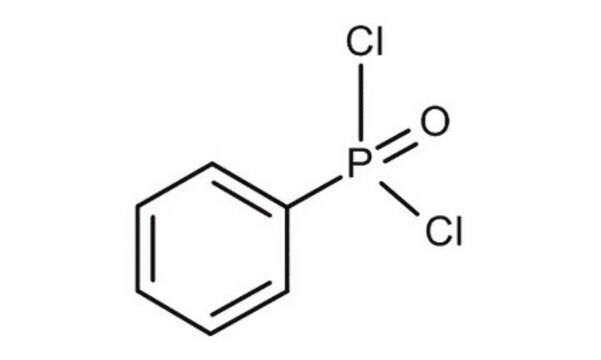389560
Phenylphosphonic dichloride
technical grade, 90%
Sinónimos:
Benzenephosphonic dichloride, Benzenephosphonyl chloride, Phenyldichlorophosphine oxide, Phenylphosphonyl dichloride, Phenylphosphoryl dichloride, P,P-Dichlorophenylphosphine oxide
Seleccione un Tamaño
84,10 €
Seleccione un Tamaño
About This Item
84,10 €
Productos recomendados
grado
technical grade
Nivel de calidad
Ensayo
90%
Formulario
liquid
idoneidad de la reacción
reaction type: Buchwald-Hartwig Cross Coupling Reaction
reaction type: Heck Reaction
reaction type: Hiyama Coupling
reaction type: Negishi Coupling
reaction type: Sonogashira Coupling
reaction type: Stille Coupling
reaction type: Suzuki-Miyaura Coupling
reagent type: ligand
índice de refracción
n20/D 1.559 (lit.)
bp
258 °C (lit.)
mp
3 °C (lit.)
densidad
1.375 g/mL at 25 °C (lit.)
cadena SMILES
ClP(Cl)(=O)c1ccccc1
InChI
1S/C6H5Cl2OP/c7-10(8,9)6-4-2-1-3-5-6/h1-5H
Clave InChI
IBDMRHDXAQZJAP-UHFFFAOYSA-N
¿Está buscando productos similares? Visita Guía de comparación de productos
Aplicación
It can be used:
- In the synthesis of PBPP (3,9-diphenyl-3,9-dioxa-2,4,8,10-tetraoxa-3,9-diphosphaspiro-5,5-undecane), another organo-phosphorus flame retardant.[2]
- As a reactant in the synthesis of perfluoroalkyl(phenyl)phosphinic acids from perfluoroalkyl Grignard reagents.[3]
- As a starting material for the synthesis of benzoxazine monomer containing phenylphosphine oxide which can be polymerized via ring-opening polymerization.[4]
- As a chlorinating agent for the conversion of thienopyrimidinedione into 4,6-dichlorothienopyrimidine.[5]
Palabra de señalización
Danger
Frases de peligro
Consejos de prudencia
Clasificaciones de peligro
Acute Tox. 4 Oral - Eye Dam. 1 - Skin Corr. 1B - STOT SE 3
Órganos de actuación
Respiratory system
Riesgos supl.
Código de clase de almacenamiento
8A - Combustible corrosive hazardous materials
Clase de riesgo para el agua (WGK)
WGK 3
Punto de inflamabilidad (°F)
399.2 °F
Punto de inflamabilidad (°C)
204 °C
Equipo de protección personal
Faceshields, Gloves, Goggles, type ABEK (EN14387) respirator filter
Elija entre una de las versiones más recientes:
¿Ya tiene este producto?
Encuentre la documentación para los productos que ha comprado recientemente en la Biblioteca de documentos.
Los clientes también vieron
Filtros activos
Nuestro equipo de científicos tiene experiencia en todas las áreas de investigación: Ciencias de la vida, Ciencia de los materiales, Síntesis química, Cromatografía, Analítica y muchas otras.
Póngase en contacto con el Servicio técnico












